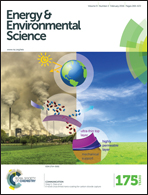Carbon nanotube-based hybrid hole-transporting material and selective contact for high efficiency perovskite solar cells†
Abstract
We demonstrate a high efficiency perovskite solar cell with a hybrid hole-transporting material-counter electrode based on a thin single-walled carbon nanotube (SWCNT) film and a drop-cast 2,2,7,-7-tetrakis(N,N-di-p-methoxyphenylamine)-9,9′-spirobifluorene (Spiro-OMeTAD) hole-transporting material (HTM). The average efficiency of the solar cells was 13.6%, with the record cell yielding 15.5% efficiency. The efficiency of the reference solar cells with spin-coated Spiro-OMeTAD hole-transporting materials (HTMs) and an evaporated gold counter electrode was 17.7% (record 18.8%), that of the cells with only a SWCNT counter electrode (CE) without additional HTM was 9.1% (record 11%) and that of the cells with gold deposited directly on the perovskite layer was 5% (record 6.3%). Our results show that it is possible to manufacture high efficiency perovskite solar cells with thin film (thickness less than 1 μm) completely carbon-based HTM-CEs using industrially upscalable manufacturing methods, such as press-transferred CEs and drop-cast HTMs.


 Please wait while we load your content...
Please wait while we load your content...